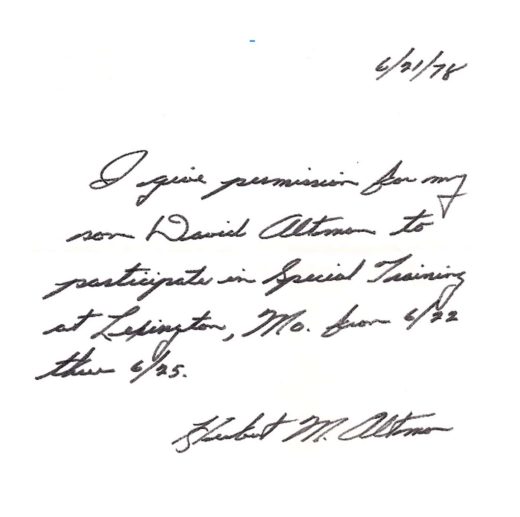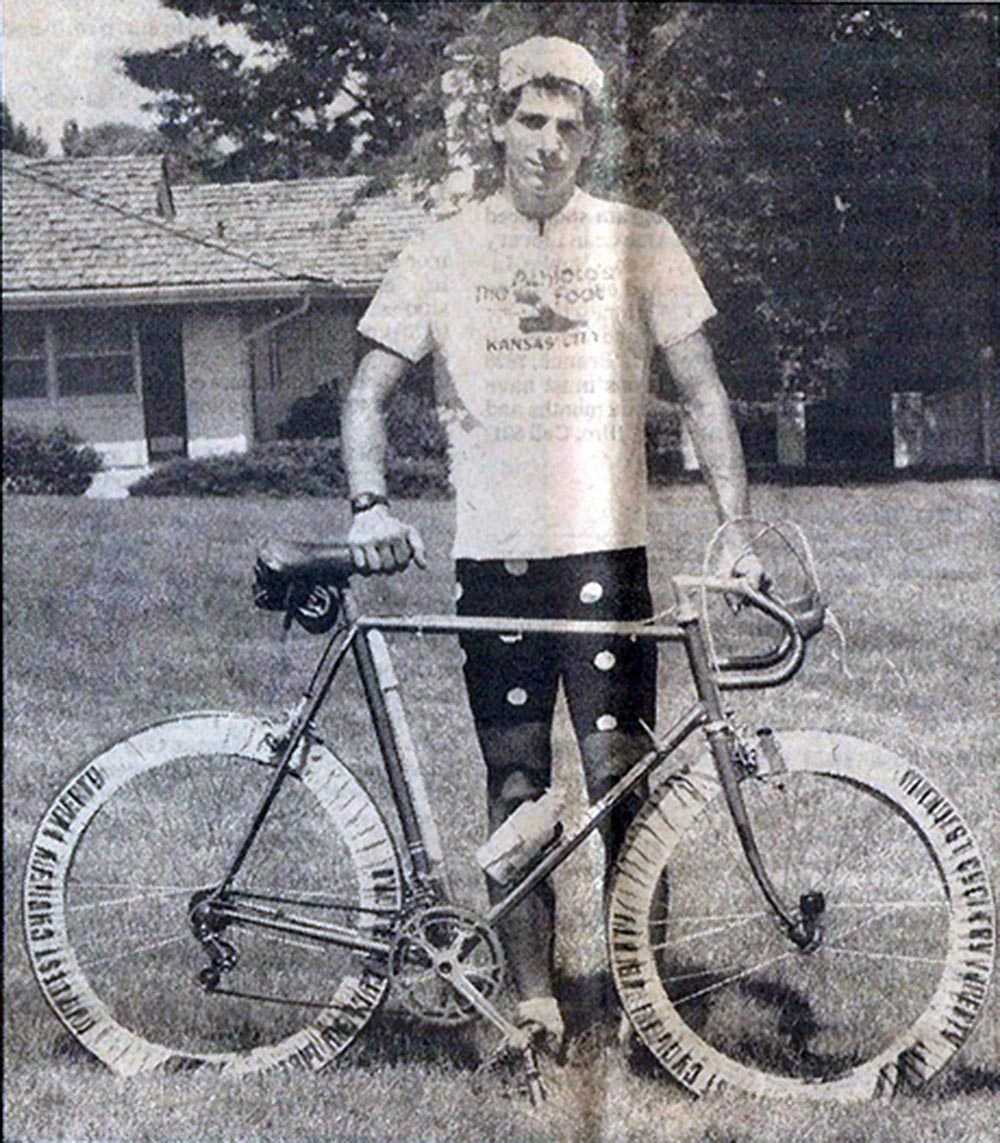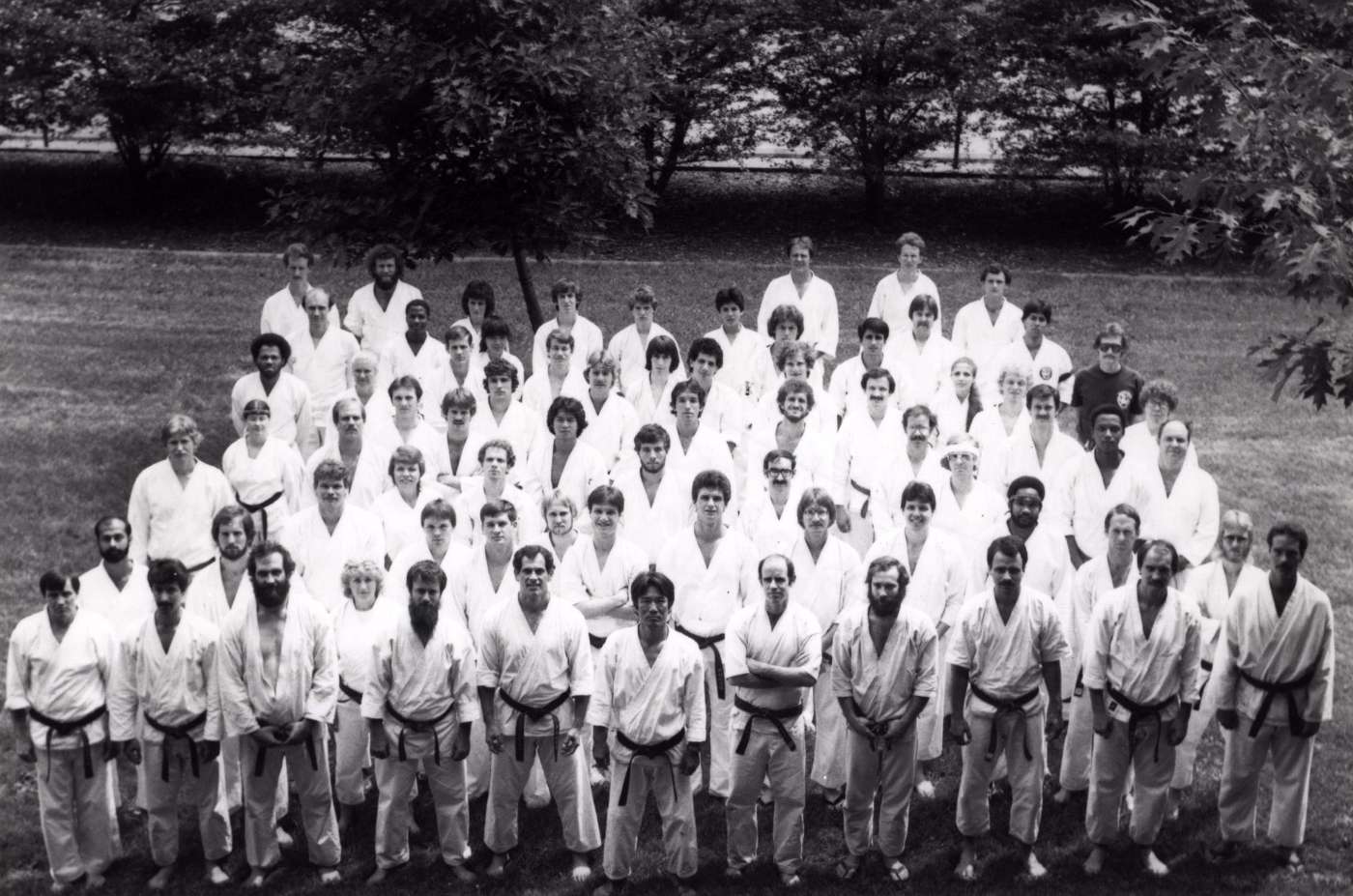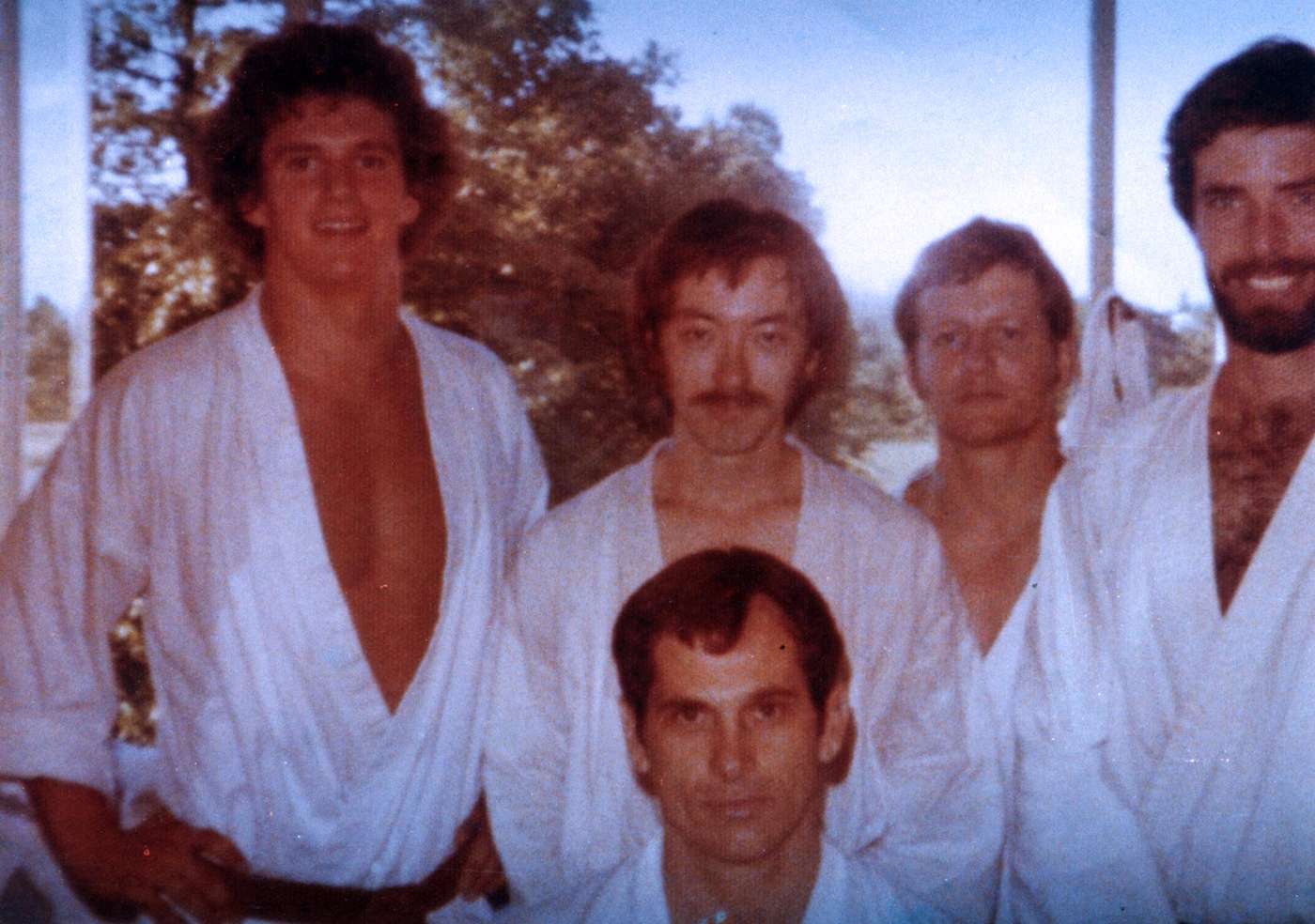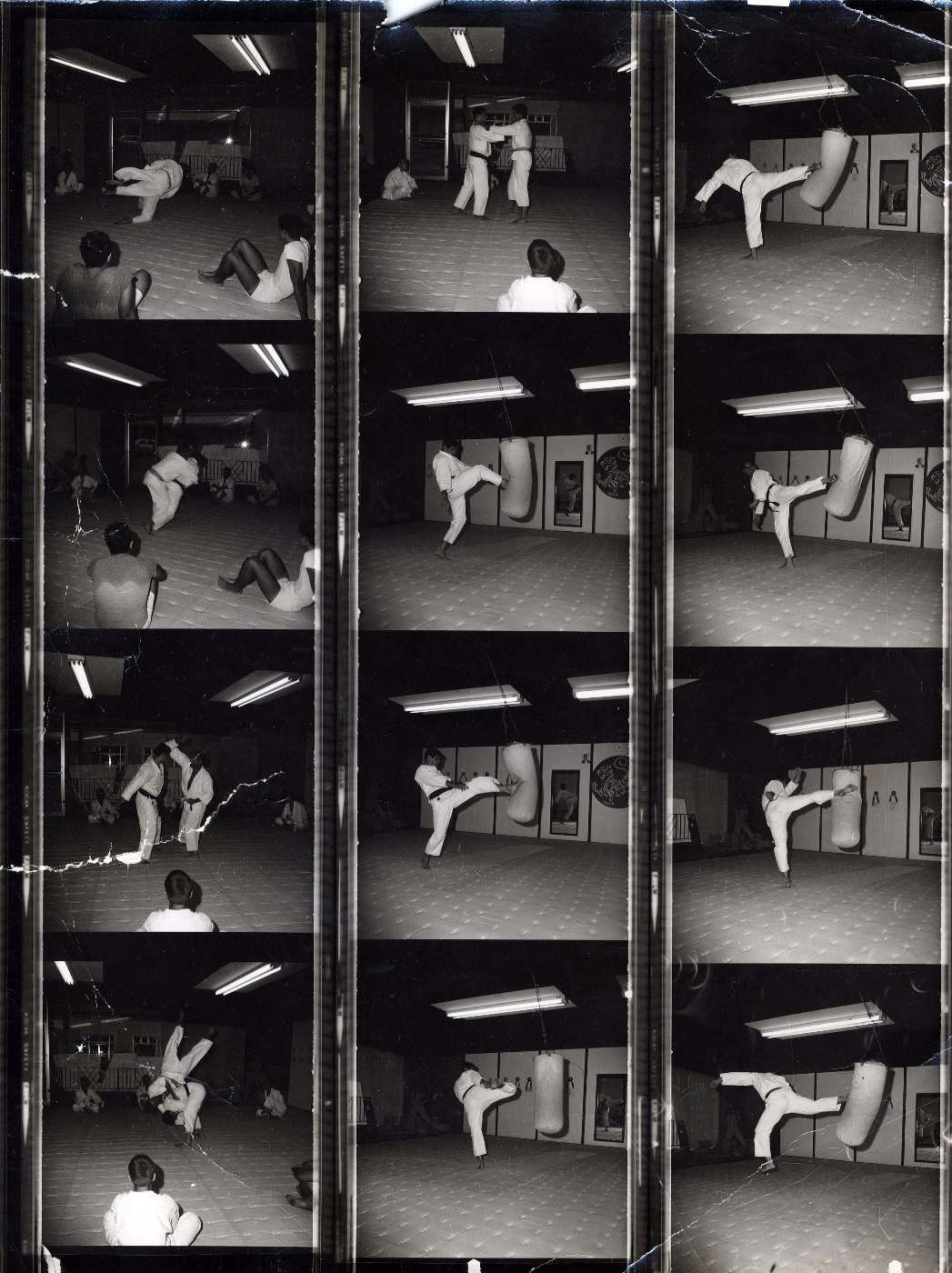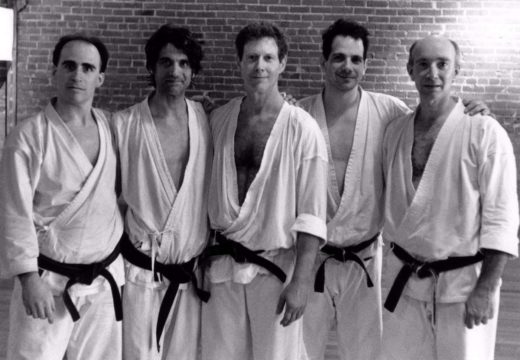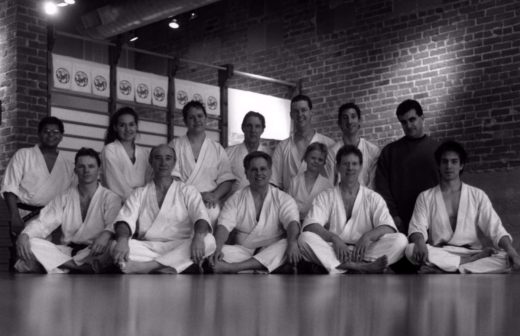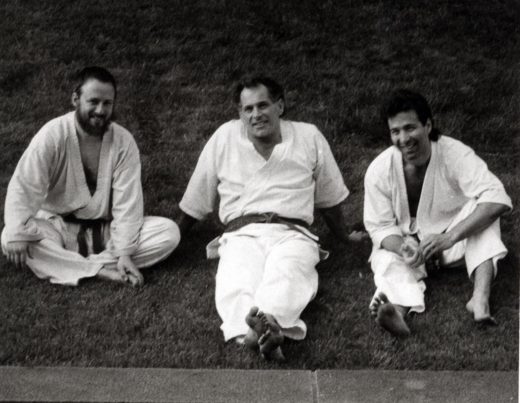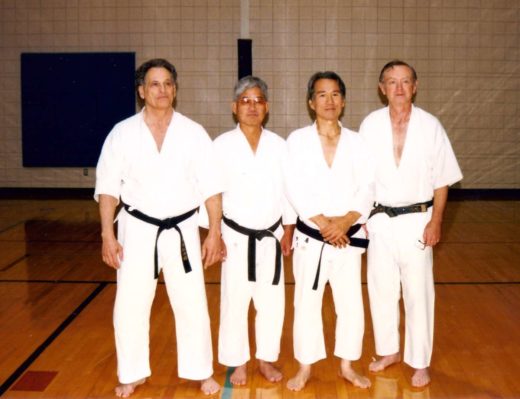David Altman (godan 1976)
As Master Funakoshi said, “We practice so long as we breathe.” One of the most significant events in my life was meeting Jon Beltram. I was a 16-year-old high school student. I’d heard that Mr. Beltram taught some kind of ancient martial art in the basement of a church. I asked Mr. Beltram if my friend, Toam Che, and I could come practice. My friend Toam loved to fight, and he asked to fight one of the black belts. Jon let him fight Donnie Duncan and Donnie knocked him out. My friend had made a big mistake, and he never came back to practice, but I did.
Not long after I started practice, Mr. Ohshima visited Kansas City to give a dan test. I had no idea who he was, but I knew that what I witnessed was something special. I truly believe that every moment in our life is significant. We just don’t realize it at the time. Only later when we gain insight and remember do we realize all those moments were, in fact, so meaningful. What is critical to practice is to train hard, honestly and unselfishly, and to throw oneself into training wholeheartedly and to do one’s best. Through practice, I have developed a mentality to never ever give up, and to always put forth my very best effort.
Another significant moment I will never forget occurred during the early 1980s. I was attending college in Seattle and I had to get to special training in the Midwest, but I’d only managed to save enough money to pay the special training fee, not the travel expense. I didn’t want to borrow money from anyone, but I’d promised Mr. Beltram I’d attend. I had been training for the Ironman World Championship in Hawaii and I’d put a lot of miles on my bike. So I thought, “Why not ride my racing bicycle to special training? It’s free, I am pretty fast, and I can see lots of beautiful scenery.” The problem was I only had eight days to get there and I knew not to be late. “OK,” I thought, “Eight days. 1600 miles. I can do that!” I planned my route and took off the next day. I only carried a lightweight backpack with just the bare essentials. I stayed in the backyards of strangers, in the basement of a church, and a few folks invited me into their homes after I explained what I was doing.
Anyway, I made it to the Midwest in time. I was exhausted and sore and my back and knees were totally shot. I honestly barely survived that special training, but I learned one very valuable, important lesson, “Never, never, NEVER, (I bet you think I’m going to say “give up”, right?) ride your bicycle 1600 miles to special training again!” But I did it again the next year, anyway.
If it were not for meeting Jon Beltram that day in high school, I know my life would have followed a completely different path. Better or worse, who knows? But one thing I am sure of is that Jon put me on a path that changed everything. A path that introduced me to Mr. Ohshima and all the great karate-ka of Shotokan Karate of America. I am still learning, still growing and still teaching what has been passed down to me from all my seniors.
David Mills (sandan 1968)
I’m trying to remember some of our first special trainings. I think our first special training as the KC Dojo was in 1974.. We were practicing at St. Ann’s Catholic Church. Seven of us made the trip to California; Bill Merkel, Guy Richardson, Mike Smith, Greg Barstow, Jon Beltram, me (David Mills), and one other guy – a very tall Special Forces Vietnam Veteran – I can see his face, but I can’t remember his name. We didn’t know what to expect. For most of us it was our first special training. Jon had really prepared us well. Physically of course, but also mentally.
Jon and Greg were the only black belts. The rest of us were brown belts. I was so impressed – Jon had his sanbon gumite and oi-zuki down! At hajime, he was a freight train doing three lunges and all his opponents could do was get out of the way. He had a black eye from Jeff Klein.
There was Hamburger Hill. Anyone who did the Cate School run knows it. At the very end of every practice, that steep run up Hamburger Hill. Like running on volcanic cinder rock! Exhausted and still running up that long steep winding steep hill that took the skin off many feet by the last day. It was a great setting for the training in Carpinteria, California.
Other special trainings… I don’t remember if it was Champaign, IL or Lexington MO, but at the last practice Mr. Ohshima had Jon face Phil Morgan in jiyū-kumite. Everybody knew Phil was no slouch. I think we were all amazed and proud of Jon’s performance. He won all rounds. That will always stand out in my mind. I wish you could’ve seen it. In class, we’ve all faced the might and fury of Jon Kent Beltram. Well, this one was text book. Jon was so calm, so controlled, his technique so well executed. Like when we do renzoku-waza (combinations) in class, only Jon was against a opponent. Jon wasn’t out of control or wild or making contact. Jon’s techniques were well placed. Steady. He’d throw a mae-geri followed by oi-zuki followed by mawashi-geri making scoring points. I think Mr. Ohshima was surprised and also approving of Jon that day. I’m thinking, “Where’s this guy been hiding in all the crazy classes back home?” Jon always rises to the occasion.
Phil was a good fighter and must’ve felt the loss, because the next special Training was in Lexington and Phil told Mr. Ohshima he’d been doing 500 gyaku zuki every day with Jon in mind. But Mr. Ohshima had him face someone else that time. You could feel Phil’s disappointment. We were so lucky Mr. Ohshima took the time to oversee those early special trainings and dan tests. It made a big difference. I didn’t realize it at the time. That strong fudōshin (immovable mind) rock, always standing watch, the example, the inspiration, the leader, emanating the tone and atmosphere reminiscent of Master Funakoshi’s Karate-do My Way of Life, of Master Azato doing similar in his training.
One of the unique training rigors of Jon Kent Beltram (JKB) vs. anyone in the whole wide karate world back then was his real life experience. This set him apart from every dojo-trained fighter no matter how good they were. Let’s put it this way: In a controlled contest with rules, referee, breaks, points, rounds, and politics, anyone might easily be judged the winner. Step out onto the street, where it’s survival, life or death, and it’s whole different game that Jon will win every time.
There are some things you can’t develop training only in a gym or a dojo. Jon has been fighting his entire life. As a young man, he excelled in hard contact sports like boxing and collegiate football. As an adult, he spent years working as a bouncer in the kind of drinking establishments where eyeballs were swept off the floor every night. He had the goods like no one else. Face it, the most high ranking sport karate martial artist who has never been hit or taken out with extreme prejudice will be in for the shock of his life in a real fight. There won’t be any yame, rules, points, or time-outs. The end is when someone can’t continue – knocked out or worse. That’s a missing part of modern training. You have to be able to take it, not just dish it out, and Jon can take it, like no one realizes. There were people who got so frustrated because they wanted to take him out, but they just couldn’t. They’d hit him so hard, a normal knockout, but JKB never gave up or gave in… And Lord help you if you went after him!
Jon can take a lot of punishment. In the early days, he would blitz – meaning run you over like a Mack truck – and even though he’d overcome you and had you crumpling against the wall, he wouldn’t stop. The punches just kept coming, a habit from his street boxing days. So Jon naturally trained you to protect yourself and to figure out how to get out of those situations. This was good training, but eventually Jon grew out of being so rough in practice. Sometimes I think that’s unfortunate.
Mr. Ohshima used to talk about how when he was first practicing, his seniors beat up on him. He said he hated them, but he was happy that they trained him so seriously. I feel the same way about my practice with Jon. It’s like a badge, to say I was worked over by JKB. Like Mr. Ohshima, I look back in appreciation and gratitude for getting this unique training. As Nietzsche said, “That which does not kill us, makes us stronger.”
A half-century. Wow!
Dom Pizoli (godan 1972)
I would like to thank Mr. Ohshima and Jon for giving me the opportunity to change my life and for helping me to not waste my time on this earth. I appreciate their time and dedication to this martial art and to their students. Without them I would have turned out quite differently.
Greg Oliver (sandan 1989)
I first met Jon Beltram in the late ‘80s. We were both working out at the same gym. I was in my late thirties and he in his late forties. I was in good shape at the time and I noticed how Jon in his late forties was able to outdo me in every aspect of our workouts. It was pretty impressive! We would talk off and on at the gym and one day when leaving I saw some flyers on the front desk with a picture of Jon and Mr. Ohshima and their bio’s. I immediately asked him about his karate class and asked if I could come try it out. He said “of course, just come in some loose fitting clothing and try a few classes and see if you like it.”
I went to his class the next day and although I was fit and coordinated I felt awkward, slow, and pretty much like a fish out of water. He asked me at the end of class how I liked it and I said I wanted to join. Jon said I could try a few more classes before deciding. I told him “no, I already know that I want to continue.” Little did I know at that point in my life that the path I chose to take that day would impact me for decades to come.
Practice gave me a new outlook on my life and how I viewed myself. It enabled me to know how much more I could do when I thought I couldn’t. It also gave me the most precious things in my life. My dearest friends and my wife are all connected to the path I chose the day I started practicing with Jon.
Mike Lyon (yodan 1984)
My brother-in-law, Andy Brown, had been practicing for several years and had been encouraging me to go with him to practice. But I kept refusing, “I’m not into violence.” I’d ended my 1960s Jiu Jitsu practice after I’d severely but unintentionally injured my partner during free-fighting. Andy kept after me, and eventually I was feeling flabby and I asked him about practice. In his living room, he demonstrated Heian Nidan and I was so impressed by his utter seriousness. And he told me he thought I’d be good at it and that practice would help me lose some weight. So we agreed to meet a few days after Christmas, and I followed him to the Shawnee Community Center for my first Shotokan practice.
The Center was a dilapidated metal building standing on a concrete pad. The dressing room was heated to just above freezing, but the practice area had neither heat nor air conditioning. Water would seep up through the cracks in the floor making it both cold and slippery. By February the water actually froze so we practiced on a thin sheet of ice. Truly Spartan! When I arrived in December, however, it was only very cold and not actually freezing.
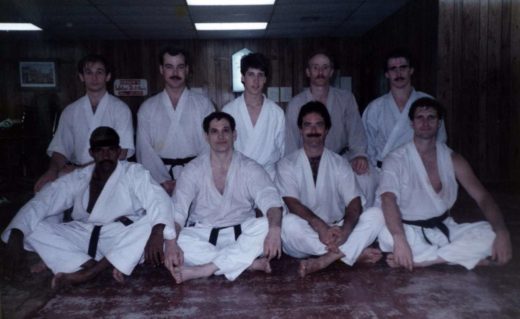
There were maybe eight or nine people at that practice, all men wearing white uniforms, three or four black belts, three or four brown belts, and a couple of white belts. I wore sweats. The leader, Jon Beltram, called for us to line up. Somebody pulled me to the junior end of the line and we knelt and Mr. Beltram gave a brief speech which went something like, “Mizu-no-kokoro means mind like water. That’s how your mind should be during practice. Calm like a still pond. The kind of water that clearly reflects the moon. If you start thinking, it’s like throwing pebbles into the pond and the ripples destroy the moon’s reflection. Clear your mind!” And the guy at the senior end of the line shouted “Mokuso!” and I sat there thinking, “Man, this is so cool! Been a long time since I had anything spiritual in my life!”
When we stood up, Jon assigned David Altman to teach me basics. David introduced himself. He was 25 years old and not at all the kind of person I expected in a 2nd degree black belt. He was very, very patient, kind, and gentle. Even though I felt awkward and embarrassed as I tried to mimic his movements, David really encouraged me and made me feel comfortable.
After basics, I sat on the freezing cold floor and watched as the brown and black belts practiced kata and then fought. The fighting was AMAZING! I couldn’t distinguish the brown belts from the black belts. It looked to me like total chaos with everyone beating the daylights out of one another, but miraculously, nobody seemed to be injured. Still, it looked very rough and pretty terrifying and I was happy to have been asked to just observe. I couldn’t imagine myself EVER managing to move like those people!
Now, more than thirty years later, I owe a huge debt to Andy Brown for dragging me to practice, to Carl Johnson for carpooling with me those first couple of years so it was impossible to play hooky, to all my many seniors who taught me so gently and not so gently, and to all those amazing seniors I practiced with who pulled me along in their back-draft; Ohshima Sensei, Sada Honda, John Teramoto, Don DePree, Ken Osborne, Ron Thom, Mike Schuler, Dom Pizoli, Manfred Chiu, Mike Duray, Phil Welker, Jeffrey Klein, Tom Muzila David Altman, Donnie Duncan, David Lightner, Carl Johnson, Kelly Rudolph, Greg Barstow, David Mills, Andy Brown, and many others. Each has influenced my practice and my life for the better. Thank you!
I owe a debt I can never repay to Jon Beltram who has been both good friend and enormous influence in my adult life. Jon has taught me by his good example, clear eyes, innumerable painful demonstrations, and especially by sending me to special training again and again to throw myself body and soul into whatever I undertake, to give it my all, to do my best, to never give up, to know that I’m stronger than I imagine, and to understand that I have so much to learn.
Matt Chatfield (nidan 1999)
I recall the first chance I had to meet many of the karate-ka of the Kansas City group, and specifically recall telling Greg Oliver how “Nice and Genuine” this group was. Greg invited me to check out a practice at the dojo on Broadway and I can remember being very fascinated right away. A great number of my closest friends over the years have been made at the dojo, and during special trainings with members from other groups. I am always amazed at the integrity of our practitioners.
It is a fact that my Seniors have helped me develop into a better person by encouraging me to look at myself with strict eyes. I know I would not be where I am today, personally or professionally, if I had not learned to push myself beyond my comfort zone. When I was a young karate student, I remember being nervous driving to the dojo for practice. Over the years, anxiety has evolved into excitement that I will be spending some quality time with my best friends away from the craziness of the world. Words cannot express how thankful I am to my sensei, Jon Beltram, and my other seniors who have helped me find my direction over the years. Arigato gozaimasu!
Dom Pizoli (godan 1972)
I was a young man when I met Mr. Ohshima and Jon Beltram. Jon and I were friends before I moved to Chicago in 1987, but afterwards we became close friends and we attended many special trainings together. Practicing karate and going to special training became a way of life for me. I actually returned early from my honeymoon to attend one. My wife understood, but my grandmother couldn’t understand that at all.
My first special trainings were led by Mr. Ohshima and the later ones were led by Jon. They both helped shape my life. To this day people often ask me why I have the drive to continue doing certain things or have the ability to push beyond certain limits, and inevitability they say, “Oh, you can do that because you’re a karate man.” I laugh and agree with them and their reasoning.
Randy Morris (shodan 1970)

I began karate training in 1970 at Richard Yennie’s dojo at 39th and Main in Kansas City. It was a handicap that I lived in St. Joseph, about two hours away, but my good friend Dan Lobmire and I drove to the dojo every Tuesday for 6:30pm practice and every Saturday for 10:30am practice for a year until I was transferred to the West Coast. I finally was able to meet Jon in 1975 when I was transferred back to Kansas City.
I started attending class in the basement of St. Ann’s Church in Shawnee Mission. Jon’s teaching helped me reach a different level of thought and physical ability, and through his dedicated and unselfish leadership, I passed shodan in 1977. It was thrilling and an honor for our group to host Mr. Ohshima’s visit to our dojo and to be able to test in front of him. My training with Kansas City SKA is one of my life’s most treasured experiences.
I will be forever grateful to Jon and all the teachers who came before him. I no longer make a formal training, but not a day goes by that I don’t think about karate or practice some technique.
Thank you Jon. Thank you Mr. Ohshima.
David Gabai (yodan 1981)
Congratulations on 50 years! Though I never lived within 1000 miles of KC, your dojo has been central to my training. Over the years I went to eleven KC Spring special trainings (as well as five other Midwest special trainings). All were intense and amazing experiences and each was unique in its own way. The resulting camaraderie has created an enduring bond. I’m especially grateful to Jon Beltram, David Altman and Mike Lyon for their uncompromising focus on quality as well as their welcoming kindness. Good luck carrying on Mr. Ohshima’s teachings.
Kelly Rudolph (nidan 1973)
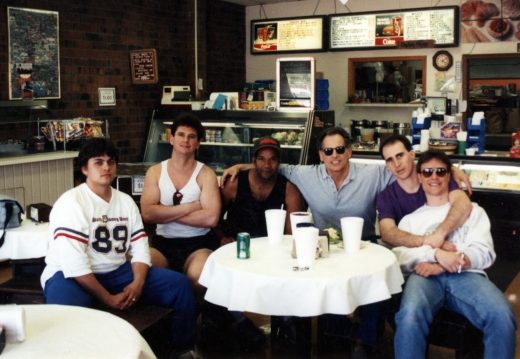
I started training with Jon Beltram in August 1973 at St. Ann’s Parish Hall. Kevin Petrehn had a family friend who told us about the karate class there. I was a pissed off guy because I’d missed a year of freshman football at Rockhurst High School because Spinal Meningitis had put me in a coma for three days and my mom wouldn’t let me play. I was going crazy from not playing and being challenged. It turned out to be one of the best things that happened in my life because I started training karate under Jon. He drilled it into me to be strong-willed, to never ever give up, to work harder than anyone else and then some. Jon’s lessons have stayed with me to this day and continue to pay off – anyone that ever tried to outdo me when it comes to mental strength has lost.
Luc Vilain (yodan 1986)
Please accept my best wishes, congratulations and thanks from the heart for the good memories and the opportunities you gave me to participate in six special trainings starting in 1990.
What can I say; I have no words. Thank you. Best.
Jim Blackmon (sandan 1958)
Of course I’d heard about Jon (he’s a legend), but I didn’t really meet him until just before the grading last summer. I wish I’d known him decades earlier, as we began practice at about the same time.
Recently I’ve been studying his essay on strategy. Very, very profound. Just the first page alone needs a lot of attention. Concepts might be easy to express, but it takes work to truly understand them. Jon does, and he has the gift to pass it on. I’ll keep working on it.
Two things that stick out in my mind. Jon’s student, David Altman, led the warm ups that got me through special training, including the second time I graded for sandan and flunked, which actually makes me proud to be part of SKA. I had two torn menisci in my knees and I was OK until the shower I took before we left for the airport. Then one knee fell apart. Six months later it was much better and I avoided surgery, so I was able to grade for sandan a third time and pass. My knees are fine now, and I still do serious stretching.
David Altman probably recalls my embarrassment: there we were, running for the umpteenth time around a California field at 0-dark-thirty and I had no clue it was him running next to me. I made the stupid comment out loud to nobody in particular, “This is beginning to get boring.” David just told me to just keep on running and I appreciated his restraint. Sigh. I’ve never learned to keep my mouth shut.
Honestly, at 70-plus years of age, I’m fortunate that I can still make a special training. It’s such an important part of my life and practice.
Carl Johnson (yodan 1980)
There are only a few people that have had an important impact on my life, and Jon is one of them. Jon has an unwavering dedication to the art of karate and to passing the art on to anyone who truly wants to learn. I was only 19 in 1980 when I first met Jon. I wanted to learn to defend myself and I’d visited a number of dojos before I found Jon practicing in the basement of St. Ann’s Church. I watched a complete two and a half hour Saturday practice and came back the next week to watch another. Of all the dojos I visited, I only returned to Jon’s. After watching the second practice, it was obvious to me that of all the instructors I had met, Jon was the only one that truly believed in what he was practicing and teaching. The next week I started practice under him, trying to truly understand the art that Jon was so passionate about. Little did I know that my journey would lead to such close friendship with a great group of people. Through blood, sweat, and hardship, our group has grown very close and the bond feels like family.
My mother said it best at my wedding, “I want to thank everyone from the karate group for being my son’s extended family.” Jon, thank you for being a guiding light which has shaped me into the man I am today.
Ohshima Sensei, thank you for inspiring Jon and for your patience keeping him on the true path of the way (I’m sure it was difficult at times). You and Jon embody the essence of the teachings of Master Funakoshi, “The way, who will pass it on straight and well?”
Richard Sheff (shodan 1975)
Congratulations for a great accomplishment to Ohshima Sensei, Jon Beltram and all the KC Shotokan Dojo for the years of dedication and hard work. I am honored to know you all.
Jim Kaplafka (yodan 1966)
I knew Jon before I came to work in KC in the mid-70s. I had been in Illinois for some years and remember an exchange practice at the University of Illinois that included Mr. Honda’s Pittsburgh area university clubs, the University of Illinois club, and Mr. Beltram’s Kansas City club. It was a memorable event that was chaired by Mr. Ohshima and even included an exhibition in jiyū kumite between Sadaharu Honda and Caylor Adkins. I have often regretted that I remember so little of that particular jiyū kumite because I was still pondering the meaning of life following my match with Jon Beltram. Care to guess who won that match?
I don’t think I ever told Jon, but before I came to live in KC, I memorized Jon’s ten-digit phone number. In the succeeding years, in spite of changes in workplace and personal residences and all the other important numbers I have forgotten, I have never forgotten that one. Jon has continued to be my KC security and finest friend, in spite of the fact that many of our parts are not the originals.
This historical document illustrates the commitment of Kansas City Shotokan to the development of the future leaders SKA and of America.
Anonymous
You have been the father who is gone, the brother who I never had and the best friend who died too young. Your leadership, wisdom and love of our art has helped me be the complete person I am today.
Michael Schuler (godan 1972)
Thank you, Jon, for showing us the true Way from the heart, and for your part in demonstrating that Mr. Ohshima’s spirit and example are capable of transforming even the most unruly bear.
Thank you Mr. Ohshima, for teaching us all, without words, who we truly could be.
With deep gratitude to my seniors.

